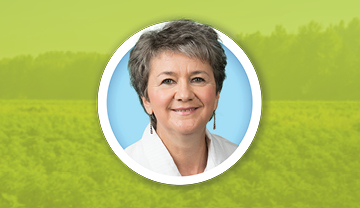
Dr. Tony Savard
Research Scientist - Food Microbiologist
Saint-Hyacinthe Research and Development Centre
Why did you become a scientist?
I have always been interested in microscopes and the amazing world they reveal, so I chose to study microbiology in university. Then, a couple of summer jobs and research contracts led me to graduate work in neuroscience. But the microbes were still calling me, so I returned to the science I was most passionate about.
Meet Dr. Tony Savard
Video transcript
*NOTE: This footage was recorded prior to the Government of Canada's physical distancing guidelines. Canadians are encouraged to continue to follow COVID-19 safety guidelines.
[Rhythmic technological music starts.]
[A glass is filled with kombucha.]
Tony Savard: The famous kombucha.
[Tony Savard and a producer analyse glasses of kombucha.]
The elixir of life.
[Tony makes a kombucha mixture in a lab. Text appears beneath him.]
Text: Saint-Hyacinthe, Quebec
What could be more natural than taking a tea infusion, adding a bit of sugar and a little fruit, and then letting it be fermented by good bacteria, good yeast, all things probiotic.
[Tony speaks to the camera in his lab.]
It's a winning formula! But watch out, there may be risks.
[Tony walks past labs to his office.]
My name is Tony Savard.
[Back to Tony in the lab. Text appears beneath him.]
Text: Dr. Tony Savard, Research scientist – microbiology, Agriculture and Agri-Food Canada
I'm a research scientist in microbiology with Agriculture and Agri-Food Canada, and I invite you to visit our lab and talk about kombucha.
[Tony brings a large jar of kombucha to a science hood and begins taking samples.]
My role right now, my challenge, is to work on documenting the functional properties of kombucha…
[Tony and another scientist analyse the results on a screen. Tony and a producer then take a tour of a large kombucha plant.]
…to ensure that the industry survives and continues to develop, but more importantly to ensure that consumers have everything they need to have a healthy product in their hands.
[Tony checks his computer in his office.]
I have never seen so many methods or tools on the Internet for home fermentation. So there are two kombucha trends that are emerging.
[Tony speaks to a group of workers in a kombucha plant.]
There is a craze for a shelf product…
[Kombucha plant workers watch kombucha bottles emerge on a conveyor belt.]
…produced by industries, but there is also this message to do it yourself at home. That's kind of where we come in, too.
[Tony works in a lab with jars of kombucha.]
We really want to document the procedures, set limits, establish zones of risk.
[Tony hooks up a bottle of kombucha to a sensor.]
For example, we know that kombucha is a fermented drink, so it's acidic. We tell the consumer, if you make it at home and after a week your product still has a pH of 5, it's still not acidic, don't drink it.
[Tony and a producer open up a vat of kombucha to check on it.]
So there's an educational aspect to it as well.
[Tony takes samples from the kombucha.]
And our role is really in that area, providing Canadians with the best possible knowledge of a product with scientific data to support it.
[Tony and the producer toast and drink the kombucha.
[Cut to a white screen with text.]
Text on screen: Learn more at agr.gc.ca/fields of science. We cover a lot of ground.
[The Canada wordmark appears. The technological music fades out.]
Profile
What do you like most about your work?
I have the chance to collaborate with food industries to fulfill the consumers' requests. They continuously bring new challenges, which stimulates me. It is the best feeling to see products I have collaborated on in my local grocery stores!
What is the coolest fact in your field of science?
Being a food fermentation specialist is not easy. Curiously, while all new scientists are studying new technologies applied to food—like electric pulsed fields, radio frequencies, high pasteurization pressure, and ultraviolet—I am working on the oldest conservation process, whose origin has been lost to history.
Who inspired your career or who is your idol?
Dr. Marcus Welby from Marcus Welby, M.D., an old television series about an old-fashioned family doctor. Then movies like Outbreak with Dustin Hoffman, and Medicine Man with Sean Connery.
What is your favourite food?
Fermented foods, of course! No, seriously, I am also a meat lover.
Classic preservation process dishes up new findings
Besides being long-time food favourites, sauerkraut and yogurt share another important quality. They're both made by fermentation, an age-old process that's enjoying a modern, high-tech resurgence in popularity.
Dr. Tony Savard, of Agriculture and Agri-Food Canada's Saint Hyacinthe Research and Development Centre, is an expert in fermented foods, one of today's hottest 'superfood' trends.
"Over time, highly processed diets and eating on the run have influenced our physical and mental health in ways that we're only now beginning to realize," says Dr. Savard. "I would like Canadians to take the time to enjoy what they're eating— including fermented products— and think about foods that are good for the entire body," he added, citing the famous philosopher Hippocrates who said: "Let your food be your medicine."
Fermentation happens when microbes, such as bacteria and yeasts, use the carbohydrates in food to produce alcohol and/or organic acids, which help preserve food and give it a distinctive tartness.
Since its first recorded use more than 2000 years ago, fermentation has been used to develop and preserve a wide range of foods and beverages, from pickles and sauerkraut to kimchi and kombucha. Now, Dr. Savard is bringing modern food science to the process for the benefit of consumers. He has an extensive knowledge of food microbiology and chemistry, which are the heart of the fermentation process.
Fermented foods contain live, beneficial bacteria— popularly called probiotics. These bacteria populate our gut and create a healthy internal environment for digestion, immunity, and many other functions scientists are just beginning to understand.
Fermentation encourages the growth of these bacteria. They remain live in the food when we consume it, unless the product is boiled or chemically treated to extend its shelf life.
Although the process of fermentation is old, Dr. Savard has contributed new knowledge that addresses consumer demands today— for price, quality and safety, and healthy eating. His findings include which microbes are the best to use for different fermented foods, how to extend the shelf life of fermented products, and how best to tweak their microbial environment to keep them healthy and working most efficiently.
Food safety is always paramount for Canadian food and beverage producers. Dr. Savard has helped develop fermentation processes that minimize contamination from a wide range of possible chemical and biological sources.
Dr. Savard is currently working on a fermented tea called kombucha that is taking the beverage market by storm. His role is to help develop recipes and production methods that maximize the safety and quality of kombucha.
Kombucha is produced from a combination of different species of fermentation bacteria and yeasts. Dr. Savard has experimented with many different match-ups to help industries choose a best-seller they can produce efficiently and safely.
Dr. Savard says he is happy to see the fermentation in the spotlight.
"Let's find better ways to preserve the healthiness of food, without treatments that destroy many of its best qualities," he says.
Dr. Savard has breathed new life into fermentation as a food preservation process. His findings continue to help food processors choose the best ferments and improve their fermentation processes for their products.
Dr. Savard's research, carried out in part with industry partners, has helped expand the range of healthy fermented foods for Canadians.
More agriculture and agri-food science

Learn how scientists are using DNA to help Canadian wheat survive environmental stressors and disease, ultimately improving the quality of farmers' harvests.

Learn how a new feeding system helps Canadian pigs get the right amount of nutrients in every meal, which impacts animal well being, is more beneficial to the environment and produces top-quality pork.

Meet our scientists, discover their work, see how their research impacts you.